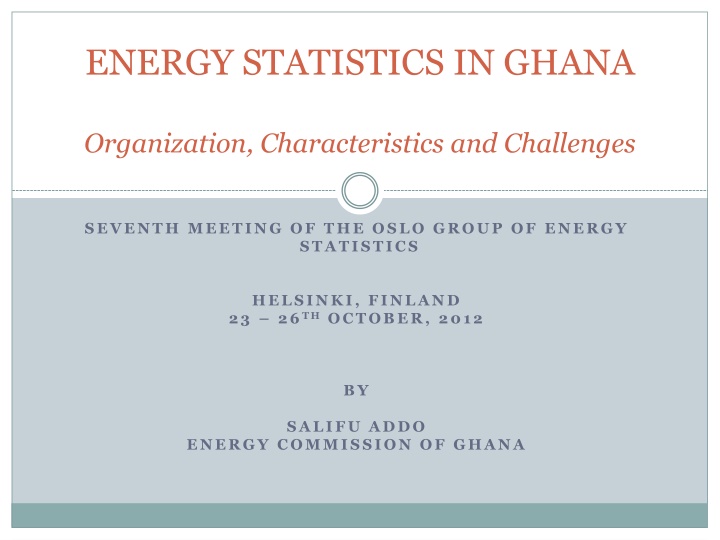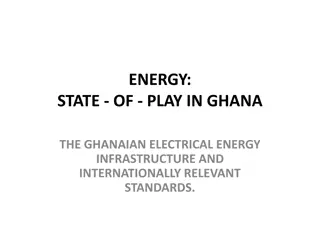Energy Statistics in Ghana: Organization, Characteristics, and Challenges
The Energy Commission of Ghana plays a crucial role in regulating, managing, and developing energy resources in the country. The organization collects various statistics related to electricity generation, crude oil production, natural gas, petroleum products, prices, demographic and economic indicators. Challenges faced in energy statistics collection are addressed, along with the organization structure and data sources.
Download Presentation

Please find below an Image/Link to download the presentation.
The content on the website is provided AS IS for your information and personal use only. It may not be sold, licensed, or shared on other websites without obtaining consent from the author.If you encounter any issues during the download, it is possible that the publisher has removed the file from their server.
You are allowed to download the files provided on this website for personal or commercial use, subject to the condition that they are used lawfully. All files are the property of their respective owners.
The content on the website is provided AS IS for your information and personal use only. It may not be sold, licensed, or shared on other websites without obtaining consent from the author.
E N D
Presentation Transcript
ENERGY STATISTICS IN GHANA Organization, Characteristics and Challenges SEVENTH MEETING OF THE OSLO GROUP OF ENERGY STATISTICS HELSINKI, FINLAND 23 26THOCTOBER, 2012 BY SALIFU ADDO ENERGY COMMISSION OF GHANA
Presentation Outline Introduction What statistics do we collect? Organization of Energy Statistics in Ghana Features of Ghana Energy Statistics Challenges to Energy Statistics in Ghana Way forward
Introduction The Energy Commission was established in 1997 under an act of parliament (Act 541) to provide for the regulation, management, development and utilization of energy resources in Ghana. The Commissions function include; Government s energy policy advisor by making national energy policy recommendations to the Minister for Energy Formulate national policies for the development and utilization of indigenous energy resources To prescribe and enforce legislative instruments standards of performance and technical and operational rules of practise for the supply, distribution, sale of electricity and natural gas to consumers by public utilities To promote energy efficiency and productive uses of electricity, natural gas and petroleum products To license utilities for the transmission, wholesale supply, distribution and sale of electricity and natural gas To secure a comprehensive energy database for national energy plan and policy research
What statistics do we collect? Electricity Generation, import, export, transmission, and distribution, losses (transmission & distribution), peak demand etc. Crude Oil Production, import for refinery and electricity generation, export. Natural Gas Production, Import, use for electricity generation, flared, re-injected Petroleum Products Production, import, export, consumption Prices Crude Oil Prices, electricity prices, petroleum product, wood-fuel (firewood and charcoal) Woodfuel Charcoal production & consumption; firewood production & consumption; woodfuel stock level etc. Demographic and Economic GDP, per capita income, inflation, population, exchange rates etc.
Organization of Energy Statistics in Ghana Annual Energy Statistics Generation VRA, IPPs Transmission, Import/export GRIDCo Electricity Distribution ECG, NEDCo Energy Balance Pricing PURC Crude Oil Production GNPC Planning & Policy Energy Commission Refinery TOR Petroleum Import & Export TOR, BDCs NPA Energy Efficiency Distribution OMCs Pricing Academic Research Production, Consumption Surveys etc Woodfuel Export Gcnet Private/NGOs Demographic, Economic etc Population, GDP etc GSS, BoG etc
Organization of Energy Statistics in Ghana contd Additional Survey Household Commercial & Service Industrial Periodicity At least every 3-5 years At least every 3-5 years At least every 3-5 years Determined from the directory of industrial establishment published my GSS Face - to face Determined based on PHC & GLSS Determined in collaboration with the GSS Sample size Interview method Face - to face Characteristics of building, floor area, Energy consumption (electricity, petroleum, renewables), penetration of electrical appliances, energy use for lighting, cooling and appliance use, energy intensities, Expenditure on energy, Energy efficiency, other sources of energy etc. Face - to face Capacity utilization, level of output, energy consumption electricity, petroleum, renewables etc), energy intensities, energy use for process heating, process cooling and refrigeration, machine drive etc, energy efficiency practices etc Characteristics of building, floor area of building, Energy consumption (electricity, petroleum, renewables), use of electrical appliances, energy intensities, Expenditure on energy, Energy efficiency, other sources of energy etc Questionnaire structure & content
Features of Ghana's Energy Statistics Section One: Energy Balance and Indicators Section Two: Electricity (Installed capacity, generation, import, export, transmission, distribution, consumption, peak demand, losses etc.) Section Three: Petroleum (Production, import, export, consumption etc) Section Four: Woodfuel (Production, import, export, consumption etc) Section Five: Energy Prices (Electricity, crude oil, petroleum products, woodfuel (firewood & charcoal) etc
Features of Ghana Energy Statistics Total Installed Electricity Generation Capacity (MW) Installed Capacity (MW) Type % Hydro 1,180 54.4 Thermal 990 45.6 Total 2,170 100
Features of Ghana Energy Statistics contd Electricity Generation (2000 2011)
Features of Ghana Energy Statistics contd Electricity Generation
Features of Ghana Energy Statistics contd Electricity Consumption by Sector (2000 2011)
Features of Ghanas Energy Statistics contd Petroleum Product Consumption (2000 2011)
Features of Ghana Energy Statistics contd Population with access to electricity
Challenges to Energy Statistics Increase in the number of institutions in the sector as a result of reform Energy market becoming more complex (from one national refinery (Tema Oil Refinery) in charge of production, import and sales of petroleum products to 9 Bulk Distribution Companies (BDCs) importing finished products and 56 Oil Marketing Companies (OMCs) engaged in distribution of petroleum products). From one electricity generation and transmission company (VRA) and one distribution company (ECG) to 2 generating companies (VRA & SAP), 1 transmission company (GRIDCo) and 3 distribution companies (ECG, NEDCo and EPC) Increase confidentiality (OMCs reluctant to release data) Difficulty in collecting primary data during surveys Non response to survey questionnaires and consumers afraid of releasing data during surveys (e.g. ECs Energy Use Survey 2010) Increasing demand for data Increasing demand for data for various policy analysis such as climate change, energy efficiency studies etc. (e.g. Office of Promotion of Energy Efficiency in EC need detailed and disaggregated data to formulate energy efficiency programmes and policies) Delay in getting response to data request from sector institutions VRA, GRIDCo, etc being state institutions delay in responding to data request made to them Lack of adequate resources Difficulty in securing the necessary funding to undertake surveys etc.
Way forward Continue to strengthen expertise and experience to ensure more accurate and complete statistics Continue to collaborate with international agency such as the IEA and UNSD in the area of capacity building to produce a more quality energy statistics Establishing a comprehensive energy database to facilitate compilation and dissemination of energy statistics Continue education of target population and the general public on the need to release data during surveys
Conclusion Idea of establishing the Oslo group is a laudable one We welcome the opportunity of working with the group Will go a long way in enhancing the quality if energy statistics across the world























